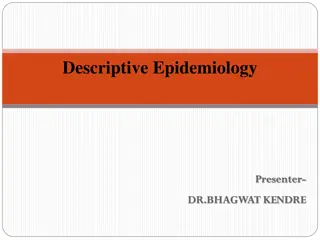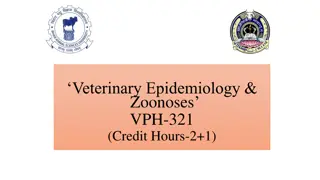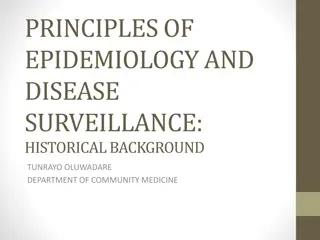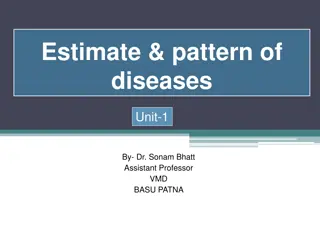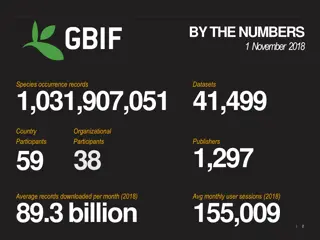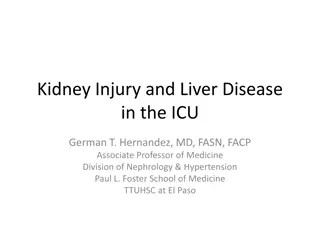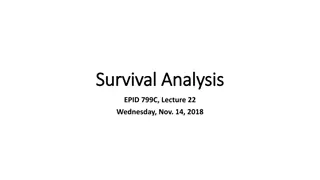Understanding Steatotic Liver Disease: Importance, Epidemiology, and Pathology
Steatotic liver disease, including metabolic dysfunction associated steatohepatitis (MASLD) and metabolic associated alcoholic liver disease (MALD), is a common cause of liver test abnormalities in the United States. Risk factors such as obesity and metabolic syndrome can lead to advanced fibrosis a
2 views • 44 slides
Innovations in Infectious Disease Control: Insights from Experts
Explore the latest advancements in infectious disease control through the lens of renowned epidemiologists and researchers. Delve into the impact of the COVID-19 pandemic, the historical prevalence of infectious diseases, and early infection prevention practices. Uncover the evolution of infectious
0 views • 22 slides
Understanding Descriptive Epidemiology for Health Analysis
Descriptive Epidemiology, presented by Dr. Bhagwat Kendre, explores the distribution of diseases and related characteristics within populations. The study delves into factors like time, place, and person to identify patterns and formulate hypotheses about disease occurrence. Utilizing data from desc
3 views • 36 slides
Understanding the Natural History of Disease Development and Prevention
The natural history of disease development outlines the progression of a disease in an individual without intervention, from exposure to outcome. Learning objectives include defining prevention terms, understanding disease severity, prevention levels, and intervention measures. Studying disease prog
4 views • 16 slides
Microplastic Occurrence in South Korean Groundwater by Well Depth and Hydrogeology
The study conducted by Kangwon National University in South Korea analyzed microplastic occurrence in groundwater from wells of varying depths and hydrogeological settings. Samples were collected from the National Groundwater Monitoring Network pipes in Gapyeong and Chuncheon. Water type analysis re
7 views • 6 slides
Best Neurosurgery Hospitals in India
Neuro diseases are very bad diseases. Many people are caught by Neuro diseases nowadays. It is related to brain diseases. Many people in India are caught by Neuro Diseases. It happens in Adults as well as children.\nA person of any age can be affected by this. Before this time very bad disease Named
1 views • 2 slides
Principles of Epidemiology: Understanding Disease Occurrence and Surveillance
Epidemiology is the study of disease patterns, factors influencing disease occurrence, and the core functions of surveillance, field investigation, and analytic studies. It involves understanding disease characteristics, natural history, and evaluating the effectiveness of activities to mitigate dis
1 views • 25 slides
Heart Health Jeopardy - Test Your Knowledge on Heart Disease
Test your knowledge on heart disease with this Heart Health Jeopardy game. Learn about heart disease facts, statistics, risk factors, and common types of heart diseases. Understand the importance of recognizing heart attack symptoms and the significance of factors like high blood pressure, high chol
0 views • 58 slides
Insights into Tyzzer's Disease: An Overview of a Bacterial Infection in Laboratory Animals
Tyzzer's disease is an acute bacterial infection affecting rodents and rabbits, caused by Clostridium piliforme. Discovered in 1917 by Ernest Tyzzer, the disease is characterized by necrotic lesions in the caecal mucosa, liver, and heart. Initially known as Bacillus piliformis, it was later renamed
2 views • 21 slides
Importance of Screening and Separation in Marburg Virus Disease Control
Early identification and separation of suspected Marburg virus disease patients play a crucial role in preventing the spread of the disease within healthcare settings. Screening and setting up specific areas for identification and isolation are essential steps to protect healthcare workers, patients
1 views • 15 slides
Understanding Glanders: A Contagious Bacterial Disease in Animals
Glanders is a contagious bacterial disease primarily affecting equidae but can also infect other animals, including humans. Caused by Burkholderia mallei, it has a historical occurrence and poses risks globally due to its transmission potential. The etiology, survival characteristics, host range, an
0 views • 19 slides
Evolution of Epidemiology: Historical Perspectives and Contributions
The evolution of epidemiology spans centuries, beginning with Hippocrates in 400 BC and progressing through key figures like John Graunt, James Lind, Edward Jenner, John Snow, and others. From the observation-based practices of ancient times to the groundbreaking experiments and analyses of the 17th
3 views • 20 slides
Understanding Resins: Composition, Occurrence, and Classification
Resins are solid/semisolid amorphous products with complex chemical composition and are found in plants, animals, and fossils. They contain essential oils, terpene products, and carboxylic acids. Resins occur as a result of normal metabolism or in response to injury, forming physiological or patholo
1 views • 37 slides
Understanding Disease Patterns in Epidemiology: Overview and Examples
Epidemiology is the study of health event distribution in populations. This includes analyzing disease patterns by time, place, and affected individuals. Diseases can be sporadic, endemic, epidemic, or pandemic, each with distinct occurrence characteristics. Understanding disease prevalence and inci
0 views • 9 slides
Understanding Disease Control and Prevention in Epidemiology
This article discusses disease control processes in epidemiology, including reducing disease incidence, duration, and transmission. It covers public policy interventions, elimination, eradication, and extinction of infectious agents. It also highlights preventable causes of disease and different lev
2 views • 10 slides
Distribution and Occurrence of Trace Elements in Urban Wetland: A Case Study of Deepor Beel, Assam, India
This study focuses on the distribution and occurrence of trace elements and pharmaceutical pollutants in the urban wetland of Deepor Beel in Assam, India. The research investigates the presence of emerging contaminants like pharmaceuticals and personal care products, providing insights into the poll
0 views • 10 slides
GBIF Data Insights and Trends Report for 2018
The GBIF Data Insights and Trends Report for 2018 provides a comprehensive overview of occurrence records, country participants, data downloads, web traffic, and more. It highlights key statistics such as species occurrence records, datasets, web traffic rankings by country, and data published throu
0 views • 16 slides
Screening for Peripheral Vascular Disease in Patients with Coronary Artery Disease
Patients with coronary artery disease should be screened for peripheral vascular disease as it is a frequent integrator of global cardiovascular risk. The association of atherosclerosis in various arterial diseases highlights the importance of identifying multisite artery disease. The prevalence and
0 views • 23 slides
Human Disease Symptom Network: Understanding Disease Relationships Through Symptoms and Genes
The Human Disease Symptom Network (HSDN) is constructed using a large-scale medical bibliographic records database to form a network of human diseases based on symptom similarities. By integrating disease-gene associations and protein-protein interaction data, correlations between symptom similarity
0 views • 37 slides
All About Fluorite: Formation, Properties, and Occurrence
Explore the world of fluorite with details on its formation as vein fillings in rocks, occurrence in various countries, common associations, naming history, physical and optical properties, and X-ray diffraction. Discover the stunning colors and unique characteristics of this fascinating mineral.
0 views • 13 slides
Understanding Aquatic Epidemiology in Fish Populations
Aquatic epidemiology is a crucial branch of science that focuses on describing the health, diseases, and welfare of fish populations. It involves studying diseases in wild and hatchery-raised fish, identifying factors influencing disease occurrence, and conducting diagnostic investigations to mainta
0 views • 12 slides
Understanding Descriptive Epidemiology in Public Health
Descriptive epidemiology involves the study of disease occurrence and distribution in populations. It focuses on describing patterns of disease occurrence based on who gets sick, where rates are highest and lowest, and temporal patterns of disease. Descriptive studies are essential for public health
0 views • 18 slides
Understanding Bacterial Diseases of Fish: Columnaris Disease Overview
Columnaris disease, also known as Saddleback disease, is a common bacterial infection in fish that is often brought about by poor handling and high stress levels. This disease manifests as tail and fin rot, leading to rapid fish mortality. The causative organism, Cytophaga (formerly Flexibacter), is
0 views • 21 slides
Decoding Genetics: Insights from Alzheimer's Disease Symposium to Type 2 Diabetes Study
Explore the latest findings from the Alzheimer's Disease Genetics Symposium 2019 on disease mechanisms, drug targets, and genetic pathways. Dive into the progress made by the Alzheimer's Disease Genetics Consortium over the past decade. Transition to a Genome-Wide Association Study uncovering suscep
0 views • 42 slides
Insights into GBIF: Data Publishing and Web Traffic Analysis
Explore an overview of GBIF activities, including occurrence records, participants, web traffic data, and latest news updates such as Tanya Abrahamse being elected chair of the GBIF Governing Board. Dive into species occurrence records, web traffic statistics, and data publishing insights by country
0 views • 15 slides
The Cinematic Realism in "The Occurrence at Owl Creek Bridge
Exploring the cinematic techniques and realism portrayed in "The Occurrence at Owl Creek Bridge," this analysis delves into the use of point of view, sound effects, and mise-en-scene to immerse the audience in the main character's perspective. The film effectively conveys the harsh realities of war
0 views • 6 slides
Insights into Global Biodiversity Data and Trends
Discover the latest updates on biodiversity data from GBIF, including species occurrence records, participant statistics, web traffic analysis, and news highlights. Explore the total number of occurrence records published by country and the significant contributions made in 2016. Gain valuable insig
0 views • 15 slides
GBIF Statistics Report November 2018
The report provides insights into the data shared and accessed through GBIF in November 2018. It covers species occurrence records, datasets, participant information, web traffic statistics, and more. Highlights include the top countries in data publication and download requests, as well as the numb
0 views • 13 slides
Liver Disease Burden in Tower Hamlets
Dr. Somen Banerjee, Director of Public Health in London Borough Tower Hamlets, highlights the concerning liver disease mortality rates in the area, with high incidence of cirrhosis, cancer, and hepatitis B and C. The data reveals a significant burden of liver diseases such as Non-Alcoholic Fatty Liv
0 views • 18 slides
Understanding Kidney Injury and Liver Disease in the ICU
This presentation delves into the intricacies of acute kidney injury (AKI) and its occurrence in patients with liver disease in the intensive care unit (ICU). It covers the definitions, classifications, and causes of AKI, emphasizing the Hepatorenal Syndrome, a form of functional renal failure in en
0 views • 29 slides
Understanding Ecology of Diseases: An Overview
Ecology plays a crucial role in the study of disease patterns and transmission. By understanding the ecological factors influencing disease spread, researchers can predict outbreaks and develop effective control strategies. Concepts like animal populations, food availability, and competition shape t
0 views • 11 slides
Understanding Inflammatory Bowel Disease: Crohn's Disease and Ulcerative Colitis
Inflammatory Bowel Disease (IBD) encompasses Crohn's disease (CD) and ulcerative colitis (UC), chronic conditions with immunologic basis. This article delves into the epidemiology, pathophysiology, and differences between CD and UC, highlighting clinical features, pathology, and complications like a
0 views • 42 slides
Understanding Muscovite Mica: Types, Occurrence, and Exploration
Muscovite mica, a mineral with versatile industrial applications, is explored in detail through its types, occurrence in nature, and methods of exploitation. Muscovite, along with Phlogopite, forms the main classes of commercially significant micas, primarily used in various industries worldwide. Wi
0 views • 16 slides
Introduction to Survival Analysis in Epidemiological Research
In epidemiology, survival analysis is used to analyze time-to-event outcomes like time until death or disease occurrence. It evaluates the effect of treatments on outcomes and considers both event occurrence and timing. This involves various methods such as the Kaplan-Meier estimator, hazard analysi
0 views • 20 slides
Understanding Infectious Diseases and Prevention Strategies
Infectious diseases are caused by pathogens like bacteria, viruses, parasites, or fungi invading the body. These diseases can spread from person to person and sometimes from animals to humans. Common characteristics include potential severe outcomes, transmission modes, and the role of pathogens. Th
0 views • 27 slides
Ultrastructural Alterations of Renal Tissue in a Male Patient with Fabry's Disease
Fabry's disease is a rare X-linked lipid storage disorder characterized by deficient lysosomal alpha-galactosidase A activity. This condition primarily affects males, leading to chronic kidney disease and progression to end-stage renal disease. Kidney involvement is a critical aspect, and high doses
0 views • 24 slides
Chemical Reactions: Writing, Balancing, and Mastering Skills
Explore the essential topics of balancing chemical reactions, determining reaction occurrence, memorization tips, and using solubility tables. Master the art of writing and balancing reactions through fundamental rules, techniques, and practice examples. Understand the basics of chemical reactions,
0 views • 20 slides
Understanding Cohort Studies and Disease Risk in Epidemiology
Cohort studies play a crucial role in epidemiology, allowing researchers to assess the relationship between exposure and disease risk. By describing different study designs, calculating risks, and understanding population at risk, valuable insights are gained to prevent adverse health outcomes. Risk
0 views • 37 slides
Insights into GBIF Data: Occurrence Records and Web Traffic Analysis
Explore data on Purple Gromwell occurrence in Catalonia, Spain, GBIF network statistics, web traffic insights, occurrence records published by country, and data download requests in 2018. Gain valuable information on species occurrence records and user engagement trends from the GBIF platform.
0 views • 15 slides
Understanding Viral Pathogenesis: Causes and Consequences
Viral pathogenesis involves the process by which a virus leads to disease, exploring the interplay between viral and host factors. It encompasses the concepts of virulence, viral disease, and the effects on infected cells and the host's immune response. Changes within infected cells, including cell
0 views • 26 slides


